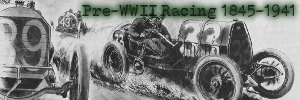|
By accessing or using The Crittenden Automotive Library™/CarsAndRacingStuff.com, you signify your agreement with the Terms of Use on our Legal Information page. Our Privacy Policy is also available there. |

EVENTS OF THE DAY IN THE WORLD OF SPORT
|
|---|
|
|
EVENTS OF THE DAY IN THE WORLD OF SPORT
The New York Times
April 15, 1900
First Automobile Fifty-Mile Race Ever Run in America.
WON EASILY BY A. L. RIKER
He Covered the Long Island Course in a Trifle Over Two Hours in an Electric Machine.
Automobilists yesterday saw the first record for a fifty-mile road race established in America. Under the auspices of the Automobile Club of America a fifty-mile race was run off on the Merrick Road, between Springfield and Babylon, for a silver cup presented by Leonce Blanchet, one of the founders of the Automobile Club of France.
A. L. Riker won the trophy with his electric carriage, the one he rode being the only electrically propelled vehicle in the contest. The others were gasoline and water carriages.
Of the fifteen members of the club who entered for the speed test, nine appeared at the starting point, which was at the junction of the Merrick Road and Springfield Avenue. The route was to Babylon, turning near the Sherman House, and then back to the starting line. The competitors, with times of starting, finishing and elapsed time, were:
| Start. | Finish. | Elapsed Time. |
| A. L. Riker........... | 10:24:00 | 12:27:30 | 2:03:30 |
| S. T. Davis, Jr........ | 1:28:00 | 12:46:27 | 2:18:27 |
| Alexander Fischer...... | 10:25:30 | 12:55:31 | 2:30:01 |
| D. Wolfe Bishop, Jr... | 10:25:00 | 1:03:08 | 2:38:08 |
| A. C. Bostwick........ | 10:24:32 | 1:11:12 | 2:46:40 |
| G. F. Chamberlin...... | 10:27:02 | 1:15:44 | 2:48:42 |
| C. J. Field............ | 10:26:36 | 1:30:30 | |
| David H. Morris....... | 1:27:30 | No time. | |
| William H. Hall...... | 10:26:00 | No time. | |
The machines were sent away at intervals of thirty seconds. Mr. Riker drew the right to start first. His machine is a low-built vehicle capable of making quick turns, and is charged with sixty cell batteries. Coming home Mr. Riker used 125 volts of electricity, and, with the exception of about ten miles, just before reaching Babylon, where the roads were rough and sandy, the vehicle was run at its highest possible pressure. As Mr. Riker came dashing over the finish line, his body bent forward as though holding the reins over some spirited steed, a mighty cheer went up from the throng of enthusiasts, and the experts afterward subjected the winning carriage to a close examination. The paint around the batteries was scorched, but otherwise it appeared no worse for its hard usage, and Mr. Riker said he had enough power left to go to New York. He partially demonstrated it by riding off with Mrs. Riker to Jamaica when the results were all in.
Some idea of the superiority of this carriage over the ordinary electric vehicle may be had when it is stated that from twenty-five to thirty miles is the limit of the latter and a new charge of electricity must then be taken. Mr. Riker's machine was the heaviest of all the racers, weighing 2,500 pounds and it has surpassed all previous records in America for a high-speed run.
At the twenty-five mile turn S. T. Davis had the lead with his locomobile, this making the first half of the journey in 0:58:13, to 1:00:36 required for the Riker machine. A powerful wind on the homeward journey cut down the speed of the lighter vehicles, so that Mr. Riker beat his rival by 15 minutes and 3 seconds. Davis had to stop twice to refill his boiler with water and lost about six minutes in so doing.
Alexander Fischer, who was the fourth man to start, rode a gasoline motor, and came in third, followed by Davis Wolf Bishop, Jr., who drove a Winton gasoline motor. Behind him were Albert C. Bostwick and George F. Chamberlin, each in a Winton carriage. David Hennen, Morris and William H. Hall, in locomobiles, broke down near Amityville, on the homeward journey. Morris patched up his carriage and limped home, bringing Hall as a passenger, a few minutes behind C. J. Field, the last man whose time was taken. The latter raced with his new three-horse power de Dion Bouton, a French automobile.
A 2¼-horse power de Dion tricycle ran over the route for a record, ridden by C. H. Tangeman, and it distanced all the big machines, making the fifty miles in 1 hour and 58 minutes.
V. Everit Macy, Whitney Lyon, and Homer W. Hedge acted as judges and timekeepers. Leonce Blanchet, the donor of the cup, rode with A. C. Bostwick, and praised the race and its management in the highest terms. Another spectator whose presence lent an additional international feature to the race was Mr. A. J. de B. Corrineau of Montreal.


















